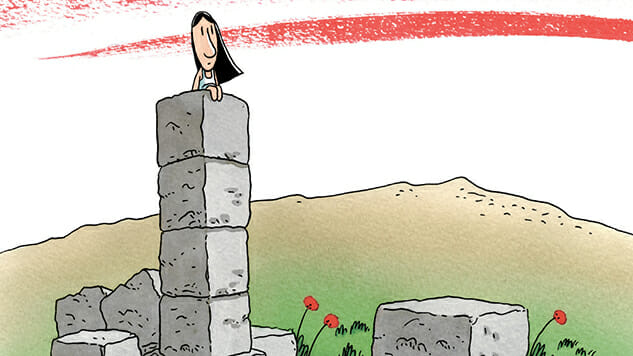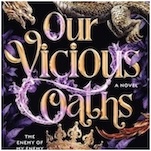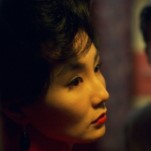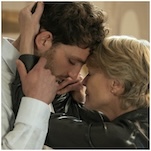Brigitte Findakly & Lewis Trondheim Show the Personal Vulnerability of Middle-Eastern Strife in Poppies of Iraq

Brigitte Findakly was born in 1959 to an Orthodox Christian Iraqi father and a French mother. She grew up in Mosul, Iraq, but moved to France with her family in 1972. Since then, she’s visited only a few times and not since 1989. Most American comic readers may recognize her as the wife of French cartoonist Lewis Trondheim, in whose Little Nothings strips she appears as a sort of long-beaked bird creature. (Trondheim interprets himself as the same mixture of human and animal, but with a shorter, sharper beak.) But Findakly has a cartooning career of her own, as a colorist, but Poppies of Iraq, an autobiography of sorts and a collaboration with her husband, offers far more insight into her storytelling prowess.
It’s a slim book with an episodic structure, and it doesn’t try to give an in-depth history of the country. Instead, it dips in and out of Iraq’s trajectory, sometimes discussing facts, sometimes politics and sometimes cultural differences, like the fact that Iraqis refuse second helpings of food, forcing the host to insist in order to get anyone to take more. The graphic novel doesn’t attempt a sweeping narrative scope, but its impact lies in the personal nature of its story. Reading a fat book about the history of a place rarely leaves the reader with empathy for the people who live there. This restrained story about individuals, on the other hand, builds bridges and leads to greater understanding, case by case by case. Findakly and Trondheim answered some questions via email about their collaboration process (they didn’t get divorced!), character design and the importance of distance in creating this story.![]()
Paste: Can you talk to me about the process of creating this book? I know Brigitte wrote, Lewis drew and Brigitte colored, but it was probably a little less separated out than that. Who did what and how did you collaborate?
Brigitte Findakly: I began with notes I had jotted down over the past few years—the things I remembered about Iraq. As I told Lewis an anecdote, often, he would ask me follow-up questions to determine more about the circumstances and the places I was describing. He also asked for photos. When I needed a little more help remembering, I’d ask my mother or my brother. Based on that information, he would edit and structure the anecdote as a comic. I would come back with more precise details and small clarifications. He would draw the page and I would color it. Sometimes I would ask him if what we were doing in Poppies was too elliptical, and he reassured me that you need to have confidence in the reader’s intelligence.
Paste: You both have a history of collaboration with other writers/artists: how is working together with each other different from working with other people?
Findakly: Lewis was there to listen, open. He knew better than anyone what would be good or bad for the book. He’s been making comics for 30 years; he knows how to structure a story. The only danger of working on this project was the risk of divorce over book-making disagreements. But that didn’t happen!

Poppies of Iraq Interior Art by Brigitte Findakly and Lewis Trondheim
Paste: Do you prefer to work collaboratively?
Findakly: I tried to write the book by myself but my writing was too sentimental. The book called for a certain distance that I wasn’t able to create on my own.
Paste: How did you know this could be a book? What was the deciding factor in starting to make it? In other words, why now?
-

-

-

-

-

-

-

-

-

-

-

-

-

-

-

-

-

-

-

-

-

-

-

-

-

-

-

-

-

-

-

-

-

-

-

-

-

-

-

-












































